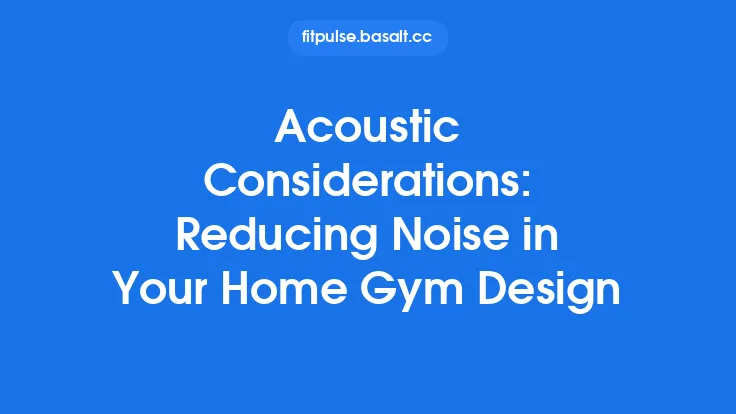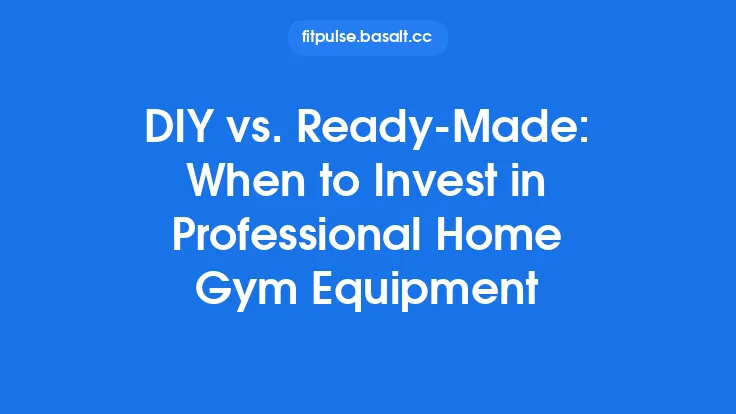When you step into a home gym, the first thing you notice isn’t the weight rack or the treadmill—it’s the atmosphere that surrounds you. Subtle cues like the hue of the walls, the shade of the floor mats, and even the color of the dumbbell handles can shape how you feel, how hard you push, and how quickly you recover. While many fitness enthusiasts focus on equipment quality or workout programming, the visual environment plays an equally powerful role in performance. By understanding the science behind color psychology and applying it thoughtfully, you can turn a simple workout space into a catalyst for motivation, endurance, and focus.
Understanding Color Psychology: Basics and How It Relates to Exercise
Color psychology explores how different wavelengths of light influence human emotions, cognition, and behavior. In a gym setting, these effects translate directly into measurable performance outcomes:
| Psychological Effect | Typical Color Associations | Potential Gym Impact |
|---|---|---|
| Arousal & Energy | Warm hues (red, orange) | Increased heart rate, heightened intensity |
| Calm & Focus | Cool hues (blue, green) | Reduced anxiety, sustained concentration |
| Motivation & Mood | Bright hues (yellow, lime) | Elevated optimism, longer perceived workout duration |
| Confidence & Power | Deep hues (purple, black) | Enhanced sense of strength, mental toughness |
Research in sports psychology shows that visual stimuli can affect perceived exertion, pain tolerance, and even hormonal responses (e.g., cortisol and adrenaline). By aligning the color palette of your home gym with the specific physiological and psychological states you aim to evoke, you create an environment that works with your body rather than against it.
The Impact of Specific Colors on Workout Performance
Red: Energy and Power
Red is the most stimulating color in the spectrum. It raises heart rate, boosts blood pressure, and can increase reaction speed. In a gym, a bold red accent wall or red‑tinted equipment can be especially effective for:
- Strength training sessions where maximal power output is desired.
- High‑intensity interval training (HIIT) where rapid bursts of effort are needed.
Tip: Use red sparingly—perhaps as a single accent wall or on equipment handles—to avoid overstimulation that could lead to premature fatigue.
Blue: Calm and Endurance
Blue is linked to tranquility and mental clarity. It can lower heart rate and promote a sense of steadiness, making it ideal for:
- Cardio endurance workouts where a steady pace is crucial.
- Yoga or mobility sessions that benefit from a relaxed mindset.
Tip: Soft, muted blues work best in larger spaces, while deeper navy tones can add a sophisticated, grounding feel without feeling cold.
Green: Balance and Recovery
Green evokes nature, balance, and renewal. It has been shown to reduce stress and improve focus, supporting:
- Recovery zones where stretching, foam rolling, or cool‑down activities occur.
- Functional training that blends strength and mobility, encouraging a holistic approach.
Tip: Incorporate green through wall paint, floor mats, or even plant life to reinforce the restorative vibe.
Yellow and Orange: Motivation and Mood
Bright yellows and oranges stimulate optimism and enthusiasm. They can make a space feel larger and more inviting, which is useful for:
- Morning workouts where a burst of positivity can jump‑start the day.
- Group or family training areas that benefit from a lively, inclusive atmosphere.
Tip: Pair yellow with neutral tones to prevent visual fatigue; a yellow accent stripe or ceiling trim can add cheer without overwhelming.
Purple and Black: Focus and Strength
Purple combines the stability of blue with the energy of red, often associated with luxury and ambition. Black conveys authority and seriousness. Together, they can:
- Enhance mental focus during heavy lifts or precision work.
- Create a “gym‑like” aesthetic that signals seriousness and dedication.
Tip: Use deep purples or matte black on equipment frames, storage cabinets, or a feature wall to convey a premium, performance‑oriented environment.
Choosing a Color Scheme for Different Training Goals
While you may have a single, unified color palette throughout your home gym, tailoring specific zones to match training objectives can amplify results.
| Training Goal | Recommended Primary Color | Complementary Accents |
|---|---|---|
| Strength & Power | Red or deep purple | Black, charcoal gray |
| Cardio & Endurance | Blue or teal | Light gray, white |
| Mobility & Recovery | Green or soft teal | Earth tones, natural wood |
| Motivation & Mood Boost | Yellow or orange | White, light wood |
Practical Example:
- Wall A (strength zone): Matte deep red on 75% of the wall, black metal shelving, and dark gray rubber flooring.
- Wall B (cardio zone): Soft blue on 60% of the wall, white ceiling, and light gray interlocking floor tiles.
- Wall C (recovery zone): Sage green on 80% of the wall, natural bamboo floor mat, and warm white LED strip lighting for gentle illumination.
By aligning color with purpose, you create subconscious cues that prime the body for the type of activity about to begin.
Practical Application: Painting Walls, Using Accent Colors, and Selecting Equipment Finishes
- Surface Preparation
- Choose low‑VOC (volatile organic compound) paints to maintain indoor air quality.
- Opt for matte or eggshell finishes for walls; they reduce glare and create a more immersive color experience.
- Accent Strategies
- Vertical Stripes: A single vertical stripe in a bold hue can elongate the space while delivering a psychological boost.
- Ceiling Highlights: Painting the ceiling a lighter version of the primary color can lift the perceived height and improve mood.
- Backdrops for Mirrors: A subtle, cool-toned backdrop behind a full‑length mirror can enhance the sense of space and calm.
- Equipment Finishes
- Dumbbells & Kettlebells: Choose handles in contrasting colors (e.g., red handles on black weights) to create visual focal points that encourage grip and engagement.
- Cable Machines & Racks: Powder‑coated frames in deep navy or charcoal provide a sleek, professional look while reinforcing focus.
- Flooring: Rubber tiles are available in a range of colors; selecting a muted green or blue can tie the floor into the overall palette without dominating the visual field.
- Color‑Resistant Materials
- For high‑traffic areas, select paints with UV‑resistance and wear‑resistant additives to prevent fading and maintain psychological efficacy over time.
Incorporating Color Through Accessories and Décor Elements
Even if you prefer a neutral base, strategic use of accessories can inject the desired psychological cues:
- Resistance Bands: Choose bands in a spectrum of colors that correspond to intensity levels; bright colors can signal higher resistance and motivate effort.
- Wall Art & Posters: Motivational quotes printed on colored backgrounds reinforce the intended emotional tone.
- Storage Bins & Shelving: Color‑coded bins (e.g., red for heavy weights, blue for cardio accessories) streamline organization while reinforcing visual cues.
- Rugs & Mats: A vibrant yoga mat in orange or yellow can serve as a focal point for warm‑up routines, encouraging a positive start.
- Lighting Fixtures: While detailed lighting design belongs to a separate article, selecting fixtures with colored glass or diffusers (e.g., amber or soft blue) can subtly shift the ambient hue without altering the structural lighting plan.
Managing Color Perception with Light and Space
Color does not exist in isolation; the quality of light—both natural and artificial—affects how hues are perceived:
- Natural Light: Sunlight tends to amplify warm colors, making reds and yellows appear more vivid. If your gym receives ample daylight, balance this by using cooler wall tones to avoid overstimulation.
- Artificial Light Temperature: Warm‑white LEDs (2700–3000 K) enhance warm colors, while cool‑white LEDs (4000–5000 K) bring out blues and greens. Choose lighting temperature that complements your primary palette.
- Reflective Surfaces: Mirrors and glossy finishes can bounce color across the room, intensifying the psychological impact. Position them opposite accent walls for a balanced visual field.
By aligning lighting temperature with your chosen color scheme, you preserve the intended emotional response throughout the day.
Psychological Pitfalls: Overstimulation and Color Fatigue
While bold colors can energize, excessive use may lead to:
- Visual Fatigue: Prolonged exposure to high‑intensity hues (e.g., bright red) can cause eye strain and reduce concentration.
- Emotional Overload: Overly saturated environments may increase anxiety, especially for beginners or those with sensory sensitivities.
- Diminished Motivation: Repetition of the same color without variation can become monotonous, eroding the initial motivational boost.
Mitigation Strategies:
- Balance Bold with Neutral: Pair a striking accent wall with neutral ceilings, floors, and secondary walls.
- Introduce Textural Variety: Use different materials (e.g., matte paint, textured wallpaper, wood panels) to break visual monotony.
- Rotate Accents: Periodically swap out small accessories—like colored kettlebells or wall decals—to refresh the visual stimulus without a full repaint.
Testing and Personalizing Your Palette: Methods and Tips
- Sample Swatches: Paint 12‑inch squares of your top three color choices on the wall. Observe them at different times of day to gauge how natural light shifts the hue.
- Virtual Visualization: Use augmented‑reality apps that overlay paint colors onto a photo of your gym space. This helps anticipate the overall mood before committing.
- Physiological Monitoring: If you have a heart‑rate monitor or fitness tracker, conduct short workout bouts in each color environment and note perceived exertion versus actual data.
- Feedback Loop: Invite a workout partner or family member to experience the space and share their emotional response. Diverse perspectives can highlight unintended effects.
- Iterative Adjustments: Start with a subtle base color and add bold accents gradually. If a particular hue feels too aggressive, replace it with a softer shade or a complementary neutral.
Maintaining Color Over Time: Durability, Maintenance, and Refresh Strategies
- High‑Traffic Paints: Choose paints labeled “high‑traffic” or “scrubbable” for walls near equipment. These formulations resist scuffs and are easier to clean.
- Protective Coatings: Apply a clear, matte polyurethane sealant on painted wood panels to guard against sweat and humidity.
- Floor Mat Rotation: Rubber floor tiles can be lifted and rotated periodically to distribute wear evenly, preserving color uniformity.
- Accessory Refresh: Replace worn‑out colored bands, mats, or storage bins every 12–18 months to keep the visual stimulus fresh.
- Seasonal Accent Updates: Swap out small décor items (e.g., throw pillows, wall decals) seasonally to introduce new hues without major renovations.
Regular upkeep ensures that the psychological benefits of your color choices remain potent, supporting consistent performance over the long term.
Bringing It All Together
Color is more than a decorative choice; it is a functional component of your home gym’s performance ecosystem. By:
- Understanding the emotional and physiological triggers associated with each hue,
- Aligning color selections with specific training goals,
- Applying those colors strategically through walls, equipment finishes, and accessories, and
- Managing light, avoiding overstimulation, and maintaining the palette over time,
you create a self‑reinforcing environment that nudges you toward higher intensity, longer endurance, and deeper focus. The next time you step into your workout space, let the colors you’ve chosen greet you—not just as a backdrop, but as an active partner in every rep, sprint, and stretch.





